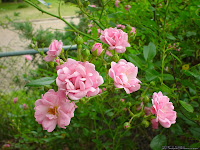Still mild and it did not rain! The group pricked out some
of the seedlings of hardy annuals which had germinated in the greenhouse, but
mostly we planted masses of bulbs in pots. Including ‘spring bulb lasagne’,
layers of bulbs in large, deep pots. (Instructions from Sarah Raven:
How to plant bulb lasagne).
 |
| Ammi majus |
The light levels are dropping and it will be cold soon.
Bridge reminded us of things to do now:
Last chance before spring to sow hardy annuals e.g. nigella, ammi, calendula, sweet peas, larkspur,
orlaya, cornflower, corncockle, ratibia, in cold frame or cold greenhouse for a
bit of protection against weather. Helps to grow them hard so that they develop
slowly but strongly. Sow ammi majus in modules so that tap root is not
disturbed by pricking out. Plant out in open beds in March.
Sow hardy broad beans
– Aquadulce Claudia variety – in pots or direct in ground. This gives an
earlier crop and helps avoid black-fly.
Plants over-wintering
Japanese onion sets in ground, leaving the tips above the earth. Or can
plant in modules to get root system established, and plant in ground a month
later.
Plant garlic
individual bulbs 2.5 inches deep in open beds.
Plant bulbs in
beds and pots – daffodils, crocus, iris etc but tulips can wait until it is
colder. In pots set bulbs close together but not touching to avoid disease.
Plant indoor narcissi
like ‘Paperwhite’ in containers (no drainage holes needed) in pure grit. Water
sparingly and stand in the light, turning every day so that they grow up
straight. Flower in approximately 6 weeks. Can continue planting up until
February for extended display if bulbs stay firm and healthy.
Plant Ident:
Shrubs and trees bearing berries:
Pyracantha
varieties (very thorny) - prune in April back to 2 buds. Red or yellow berries.
Cotoneaster (not
thorny) deciduous or evergreen small trees and shrubs e.g. C. franchetti with
orange berries, C. rothschildianus with yellow berries makes a good specimen
tree, C. watereri has red berries and is evergreen.
Hawthorn
(Crataegus monogyna) known as May, has small spines. Good for windswept
gardens. White, pink or red flowers in May. Lots of varieties available from
Notcutts Nurseries. Berries can be used in cooking.
Blackthorn
(Prunus spinosa) known as Sloe. Has big spines. Flowers very early on bare
wood. Can be used for sloe gin; put berries in freezer for 24 hours to soften.
Viburnum opulus
known as Guelder Rose, frequently seen growing wild on the South Downs. White
flowers, red hanging berries resembling redcurrants. Also worth growing:
Viburnum tinus, V. davidii, v. rhytidophyllum. All love chalk.
Euonymus europaeus
– has striking and vivid orange and pink split fruit in autumn. Bushes get very
big but there is a more compact variety.
Common Privet has
quite big black berries if left unpruned.
Sea Buckthorn
(Hippophae rhamnoides) has silvery grey foliage and orange berries. Very tough
shrub for windy/coastal sites. Berries can be used for jam.
Stag’s Horn Sumach (Rhus
typhina). Good autumn leaf colour and red velvety fruits. Suckering small tree.
Rhus ‘Laciniata’ has dissected leaves and is less invasive.
.JPG) |
| Euonymus europaeus |
.JPG) |
| Viburnum opulus |
 |
| Sea Buckthorn |
.jpg)




.JPG)
.JPG)
.JPG)
.JPG)








































.JPG)
.JPG)
